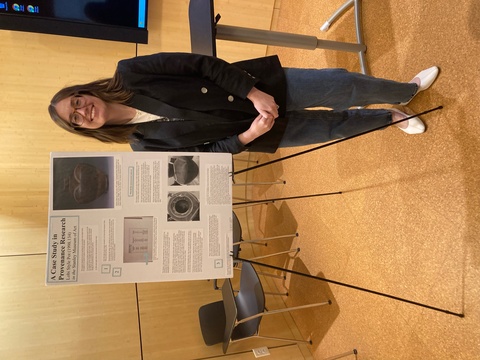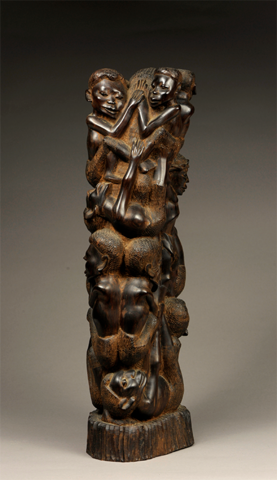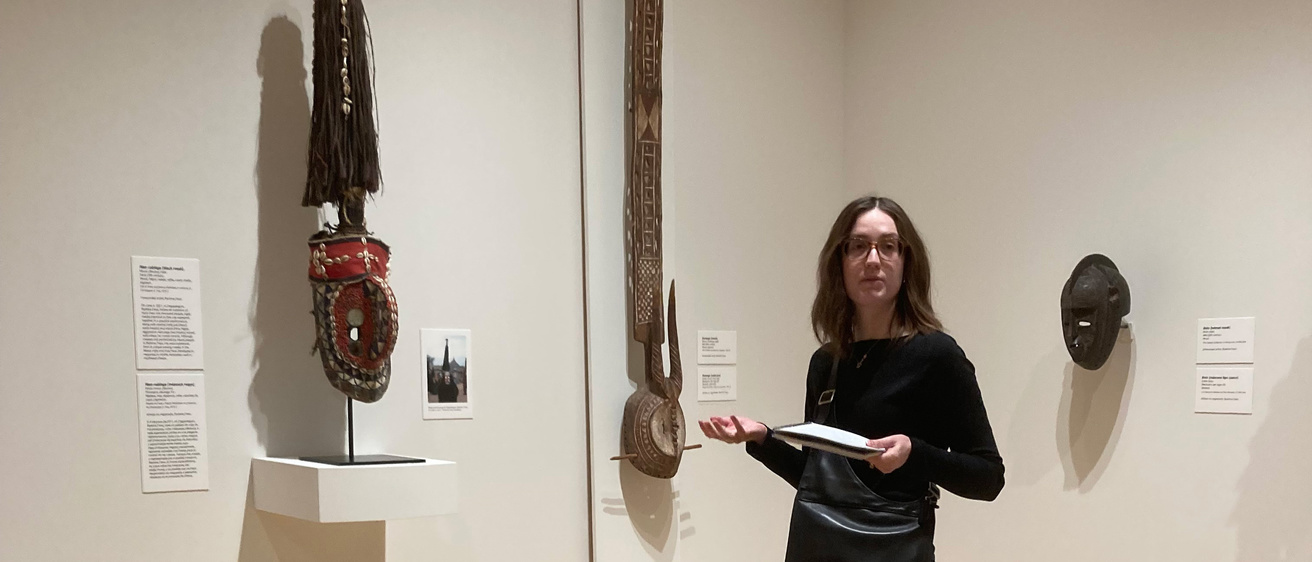
My name is Amelia Goldsby, and I’m a PhD student in art history at the University of Iowa. I completed my master’s in modern and contemporary art, and I am now focusing on eighteenth- and nineteenth-century French art. For my dissertation, I’m developing an ecocritical methodology that considers trees as actors equal to human figures in painting. This nonhierarchic approach, by drawing on artistic theory, environmental history, and scientific knowledge, will uncover new critical narratives. I’ve also served as a teaching assistant for courses like “Arts of Africa.”
In Spring 2024, I had the wonderful opportunity to take the course “Curating the Arts of Africa in America” with Dr. Cory Gundlach. In collaboration with students at the University of Indiana Bloomington, we curated an exhibition of African art from the collections of the Stanley and the Eskenazi Museum of Art that will open at the Stanley this fall. We also completed several other assignments, including writing an exhibition review and provenance research. A fascinating entry point into the ethical discourses surrounding museums and African art, the course served as important professional development for museum work. It also has intersected with my research interests in surprising ways, as well as giving me new insight into teaching with the Stanley’s African art collection.
One of the first assignments we completed was writing a label for an object on view in the galleries. I chose the Ujamaa [familyhood] blackwood sculpture (2017.166), currently on view in “Fragments of the Canon” gallery. This modern wooden sculpture appealed to me because of its densely packed figures were arranged in a tree trunk-like column and suggested a tree-human relationship, a concept I explore in a different cultural and temporal context in my own research. As such, I wrote a label that emphasized material and environmental issues:

The intertwined and stylized figures in this Makonde style sculpture reflects the term for its compositional form: ujamaa, or “familyhood.” Its densely arranged sculptural form, developed by the artist Roberto Yacobo Sangwani in the early 1960s, conveys ideas of relationships and community through the interlocking figures. This sculpture’s tree trunk-like shape and bark-like carvings on its base evoke the source of its material and visually suggest that trees are included in the concept of ujamaa. Conventionally, ujamaa sculptures are made of wood from the mpingo tree (a slow-growing, dense hardwood also known as African blackwood). Mpingo trees, due to their continued usage by the Makonde, are closely linked to artistic practice. The harvesting of mpingo trees is now limited due to dwindling populations of indigenous trees; sculptors often choose alternative woods.
What was particularly exciting to me about this assignment was that it allowed me to consider materiality in new ways. I do not usually deal with the materiality of the art object itself, but with this sculpture, its physical makeup is significant and poses some interesting questions. For instance, it is currently identified as made of ebony wood. Ebony was a name for African blackwood but now refers to a different genus altogether (mpingo trees are Dalbergia melanoxylon while ebony woods are in the Diospyros genus). Is the sculpture truly made of African blackwood, or is the identification outdated? Should woods be referred to by their indigenous names? This course, in which we dealt with objects made of wood, ceramic, metal, and fiber, has led me to emphasize materiality and the possible unique research questions it presents.
Hopefully, I will be a TA for the African survey course in the future. As this survey typically involves visiting the African collection at the Stanley, my experience in “Collecting the Arts of Africa in America” will shape my teaching in the galleries. Through reviewing current installations and curating an exhibition of our own, I will have a new way to engage in discussion with my students. Going beyond isolated visual analysis of displayed works of art, I am now prepared to ask questions that engage in curatorial and ethical issues: How does the selection and arrangement of objects convey a narrative? How might these objects have entered a museum collection? Ultimately, I am now more aware of how museums and collecting practices shaped the African art canon, allowing for an enriched and more critically-engaging experience for my students.
About Amelia Goldsby

Amelia is a PhD student in art history and specializes in eighteenth- and nineteenth-century European art. Amelia's research asks: What if we treated trees as equally important to human figures in painting? She considers trees as generative actors in eighteenth- and nineteenth-century French painting, and, by drawing on artistic theory, environmental history, and scientific knowledge, investigates how tree and human bodies create critical narratives. Having completed an MA in modern and contemporary art, she also puts eighteenth- and nineteenth-century art in conversation with contemporary work (like using eighteenth-century folly architecture to understand how contemporary sculpture imagines climate change).
